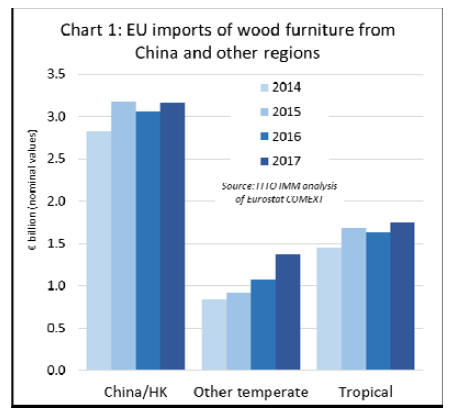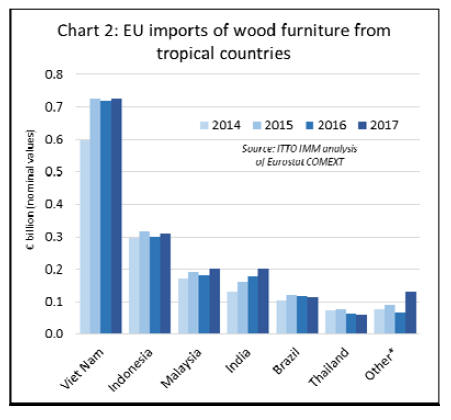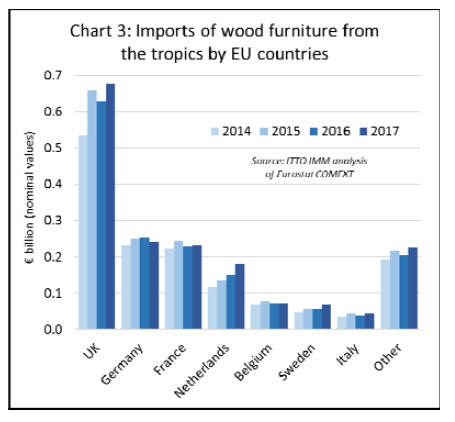|
Report from
Europe
Expanded sales of tropical wooden furniture but
market share drops
There was plenty of tropical wood furniture to be found at
the first two big European furniture exhibitions of 2018 每
the IMM interiors fair in Cologne, Germany (IMMCologne),
and the January Furniture Show at the NEC in
Birmingham, UK (JFS-Birmingham).
Judging by the stand listings, tropical timber products
were also set to have a strong presence at the biggest
international show of them all, the Milan Furniture Fair
from April 17-22.
Among the 2,000 exhibitors at the latter (including 650
from outside Italy), companies were listed from Brazil,
India, Indonesia, Vietnam and, leading the way with a
total of 12 stands, Thailand. In addition, said organising
federation Federlegno Arredo, judging by previous Milan
shows there were set to be more tropical products on
European importers*, distributors*, designers* and
manufacturers* stands.
At the German and UK shows, plantation teak and
mahogany furniture made a particularly strong showing,
while other prominent tropical species included acacia,
mango, munggur/suar (Albizia saman, also called Rain
Tree).
At both events, there seemed to be a fashion too for
recycled tropical timber products, with tables and storage
units made from a range of species recovered from old
doors, flooring, decking and even boats. Indian companies
seemed to be particularly favoured, with their style
currently in fashion, said exhibitors.
※Originally these recycled pieces looked recycled, with a
deliberately rustic finish,§ said one UK designer-importer.
※But now, manufacturers, under our guidance, are working
the wood more and going for more sophisticated, polished
styles.§
In fact, furniture from tropical countries has been
performing reasonably well in the European market for the
last four years.
There was a slight dip in EU imports in 2016, which some
attributed to the impact on wider consumer confidence
caused by the UK*s vote to leave the EU, although others
said it was small enough (under 3%), to have been &normal
trade fluctuation*. But business picked up again last year
as EU imports rebounded 7% to euro1.75 billion. (Chart
1).

Increasing competition in furniture market
However, looking more closely at the figures and wider
sales trends, the news for tropical wood furniture in the
EU is not quite as good as it might at first seem. Given the
increasingly vigorous post-recession growth of the EU
furniture market, said exhibitors and trade association
representatives at the UK and German shows, you might
have expected tropical products to have done better and
have more of a profile at trade fairs.
The fact is 每 and the statistics support the anecdotal
feedback from the trade 每 tropical suppliers have not been
keeping pace with the competition in the EU, either from
other EU import sources, or more significantly the EU*s
own robust and dynamic furniture manufacturing base. So,
while they may have grown overall sales in recent years,
they have lost market share to rival producers.
According to latest figures, EU imports from temperate
timber furniture suppliers in the last four years rose 66%,
from euro 830 million in 2014 to euro 1.38 billion last
year.
Amongst the largest increases in wood furniture imports
from temperate countries last year came from the Ukraine,
up a further 67.7% to euro 133 million, Bosnia, up 14.9%
to euro 218 million, and Serbia, up 13.7% to euro 127
million.
A further major hike in 2016, from euro 62 million to euro
150 million, is also shown in EU imports from the US, all
destined for the UK.
However, this figure needs closer examination as it could
be the result of large distributors changing sourcing policy,
or a change in reporting of products against furniture
customs code.
Other big rises came from &other temperate* producers, up
35.5% last year, notably from Turkey and Switzerland.
EU domestic furniture sector recovery and growth
The biggest shift in the EU furniture sector in recent years
has come in the degree of market self-sufficiency, with
European manufacturers taking more of their domestic
national and intra-EU trade. Further underlining their
growth and increasing competitiveness, they are also
exporting more.
According to the European Furniture Industries
Confederation, the sector was hard hit in the international
downturn from 2007, seeing turnover fall from euro136
billion to euro90 billion and shedding 280,000 jobs. Since
then, however, it has seen sales recover to euro96 billion
and its workforce to rise to over 1 million again.
In 2010, EU furniture suppliers achieved intra-EU trade
turnover of euro 15.3 billion from, while exports were
valued at euro 6.4 billion and imports at euro 5.9 billion,
delivering a euro 500,0000 trade surplus. By the end of
2017 the intra-EU trade figure had jumped 26% to
euro19.2 billion, while exports hit euro 8.8 billion. With
total imports having grown only to euro 6.3 billion, this
pushed the trade surplus to euro 2.5 billion in 2017, five
times the level of 2010.
Several reasons are given for the success and development
of the EU furniture industry. One is the maturing of
investment from Western Europe into manufacturing in
former Soviet bloc Eastern European countries, led by big
brands such as IKEA. From being principally production
satellites for companies like the latter, the plants are
reported increasingly to have developed their own identity
and market momentum.
An illustration of this is the latest market development
project from the American Hardwood Export Council
(AHEC). As part of its strategy to grow European sales of
US red oak, it has linked with leading Polish furniture
designer Tomek Rygalik. He has worked with leading
international labels, including IKEA, and is now design
director for major Polish producers Paged and Comforty.
In the AHEC project, Tomek Rygalik is creating a US red
oak furniture collection, which the Americans hope will
not only sell well and help promote the species in Poland
itself, but also in the latter*s Western European furniture
export markets. The goal is also to fire the interest of
other Polish designers.
Embracing technological change boosts EU furniture
sector productivity
Increasingly advanced computer-controlled and automated
manufacturing has also benefited European producers,
boosting their productivity, cutting overheads and
reducing the relative labour cost advantages of
competitors, such as those in Asia.
※The increasing migration of European furniture sales
online additionally favours a local manufacturing base,§
said a German designer/producer. ※It is better placed to
meet the short lead times demanded by today*s EU
internet retailers and consumers.§
Whether it also benefits domestic EU producers that sell
in-fashion timber furniture species in the EU market such
as oak is more debatable. There*s no doubting oak*s
overwhelming dominance of the sector 每 in the latest
development underlining this, it is reported that one of the
Europe*s biggest retailer/producer brands is currently
looking to sign up a supplier of up to 140,000 cu.m this
year.
But while European manufacturers may be close to
sources of European oak supply, there are few limits
placed on oak log export outside the EU. This is despite
efforts by manufacturers in France, in particular, to lobby
their government to curb log exports, notably to China.
It*s also notable that EU furniture producers import large
quantities of US white oak and that Asian producers also
have ready access to this material. In fact, a number of
companies at the IMM-Cologne and JFS-Birmingham
exhibitions were showcasing EU-designed ranges
manufactured in US white oak by joint venture or
subcontractor partners in South East Asia, notably
Vietnam.
※Source locally§ a key theme of EU manufacturers
There seems to be a growing preference in the EU market
to &source local*, particularly in the design and specifier
sectors. This is mainly to support homegrown forest and
timber-using industries - although EU furniture
manufacturers and retailers like to take credit for the
reduced transport miles and carbon footprint implied. This
is despite several recent LCA studies of wood furniture
undertaken by AHEC showing that environmental impacts
incurred during the transport phase are significantly less
than those incurred during the processing and
manufacturing phases.
In practice the carbon footprint of wood furniture is often
more dependent on the quantity and mix of energy used to
convert and dry the wood, and the energy efficiency of the
manufacturing operation, than on shipping even when
materials need to be transported over large distances.
Nevertheless, the ※source local§ theme will feature at the
Carrefour International du Bois show scheduled for 30th
May to 1st June this year in Nantes, France.
The four-year-old &Le Bois Français* campaign will once
more have a prominent presence and there will be
significant regional French timber industry representation.
In the UK, the Grown in Britain initiative, which is
supported by such leading furniture retail brands as Heal*s
and Marks & Spencer, is now in its fifth year and said to
be still increasing its impetus.
Underlining just how competitive the EU furniture market
is, even China has recently struggled to increase sales. EU
imports of wood furniture from China rose 12% to
euro3.17 billion in 2015, but since then have plateaued
around that level.
Leading tropical suppliers of wooden furniture to the
EU
In terms of the leading tropical furniture suppliers to the
EU, imports from Vietnam and Indonesia have followed a
similar trend; rising relatively strongly in 2014 but
slowing since. EU imports from Vietnam increased just
1.3% to euro 730 million last year, while imports from
Indonesia increased 3.7% to euro 310 million. (Chart 2).
There was better news for Malaysia. After dipping 5% in
2016 to euro 184 million, EU imports from Malaysia
recovered 10.3% to reach euro 203 million last year. EU
imports from India have experienced more consistent year
on year growth since 2015, with trade rising an additional
12.3% to euro 202 million in 2017.
After relatively static performance for four years, EU
imports from Brazil and Thailand both saw decreases in
2017, down 5.3% and 3.4% to euro 112 million and euro
61 million respectively.
The biggest increase last year, albeit from a modest base
of euro 69 million, came in EU imports from &other
tropical countries*, up 87.8% to euro 130 million.
Contributions to this rise came from Singapore, which is
channelling furniture to the EU from elsewhere in South
East Asia, and from the UAE and Qatar.
EU imports of wood furniture from the two Middle
Eastern countries jumped from under euro 1 million in
2016 to a combined total of nearly euro 36 million last
year. This increase all went to the UK and is either an
error in the customs statistics or could indicate a switch in
sourcing by major retailers or distributors.

In terms of EU importers of furniture from tropical
countries, the leading buyers have stayed in the same order
by sales value since 2014.
The UK remains the largest buyer, with imports up 8% last
year at euro680 million, having dipped 4.5% in 2016.
Germany is in second place, despite a 4.2% downturn in
imports last year to euro 240 million. Next is France, with
imports up 2.4% at euro 230 million, the Netherlands, up
20.5% at euro 180 million (another anomalous requiring
further scrutiny), Belgium up 2.4% at euro 70 million,
Sweden up 23.7% at euro 70 million, and Italy, up 10.4%
at euro 40 million. Other EU importers increased their
combined total 9.1% to euro 230 million in 2017. (Chart
3).

Tropical timber market promotion in the EU
In the face of falling market share, proactive steps are
being taken to consolidate and grow tropical timber
product sales in the European market.
The European Sustainable Tropical Timber Coalition
(STTC), comprising timber importers, traders, end-users
and retailers, plus public and private sector specifiers and
procurement personnel, continues its market education and
promotion efforts.
A key aim is to ensure that sustainably sourced tropical
timber products receive due and fair consideration in
business and public sector procurement policy. The core
message is that ensuring a healthy, viable market for the
timber will drive the spread of sustainable forest
management in tropical countries.
The STTC has recently been reviewing its activities,
working with various partners in the industry. Aims
include becoming more effective and efficient in
delivering key market data and also focusing more on
monitoring trade flows of sustainably sourced tropical
timber into Europe.
ATIBT, the International Tropical Timber Technical
Association, also continues to roll out its Fair & Precious
marketing/branding initiative.
This too aims to educate the market on the wider social,
environmental and economic benefits of increasing
demand for sustainably sourced tropical timber and wood
products.
All businesses along the supply chain can use the Fair &
Precious brand on their products, provided they pledge to
source third party-accredited legal and sustainable goods
and material and &commit to respecting social,
environmental and economic concerns in their activities,
subject to audit by third-parties approved by the Fair &
Precious ethics committee*.
Whether the EU FLEGT VPA initiative and FLEGT
licensing has the potential to underpin the tropical timber
market is still a matter of debate.
Indonesia, the first country to issue FLEGT licences, did
see its timber furniture sales to the EU rise marginally last
year to euro310 million. However, they have been around
that figure for the last four years, so, say importers, offer
no real clue on the market impact or perceptions of
licensing.
A key conclusion of discussions at IMM-Cologne and
JFS-Birmingham, and of the EU FLEGT Independent
Market Monitor (IMM) trade consultation held in London
during March, is that there is still a need for more market
education and communication about the wider FLEGT
initiative.
Several exhibitors at the UK and German shows and
participants at the trade consultation acknowledged they
knew little about it. They seemed particularly surprised by
the scope of licensing systems and the extent of the forest
reforms implemented as part of the FLEGT process.
At the IMM London trade consultation, Kate Towler,
Assistant Manager Sustainability and Responsible
Sourcing at retail giant John Lewis, said that companies
like hers needed to know more &human stories* behind
FLEGT which they could relay to their personnel and
consumers.
But she did conclude that the consultation had provided
&knowledge of the further capabilities of the [EU FLEGT
VPA initiative and FLEGT licensing] beyond just legality
assurance*. ※This is something I will be looking into
further with the possibility of positioning FLEGT within
our internal timber sourcing policy,§ she said.
At the same IMM event Andy Duffin, Operations Director
of one of the UK*s leading timber importers and
distributors James Latham, cautioned that the emphasis in
promoting FLEGT should not be on selling a licensed
product, but on selling the product first and as licensed
second.
※I believe that the real issue behind tropical timber*s loss
of EU volume market share is lack of promotion of
products before schemes,§ he said. ※No one buys or sells
FLEGT. We need to sell balau products, for instance, that
are also FLEGT-licensed. Environmental issues are key,
but they are side-lined if no-one wants the product.§
|